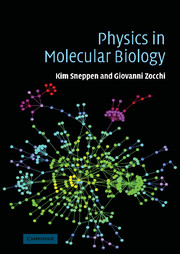Book contents
- Frontmatter
- Contents
- Preface
- Introduction
- 1 What is special about living matter?
- 2 Polymer physics
- 3 DNA and RNA
- 4 Protein structure
- 5 Protein folding
- 6 Protein in action: molecular motors
- 7 Physics of genetic regulation: the λ-phage in E. coli
- 8 Molecular networks
- 9 Evolution
- Appendix Concepts from statistical mechanics and damped dynamics
- Glossary
- Index
2 - Polymer physics
Published online by Cambridge University Press: 06 July 2010
- Frontmatter
- Contents
- Preface
- Introduction
- 1 What is special about living matter?
- 2 Polymer physics
- 3 DNA and RNA
- 4 Protein structure
- 5 Protein folding
- 6 Protein in action: molecular motors
- 7 Physics of genetic regulation: the λ-phage in E. coli
- 8 Molecular networks
- 9 Evolution
- Appendix Concepts from statistical mechanics and damped dynamics
- Glossary
- Index
Summary
Living cells consist of a wide variety of molecular machines that perform work and localize this work to the proper place at the proper time. The basic design idea of these nano-machines is based on a one-dimensional backbone, a polymer. That is, these nano-machines are not made of cogwheels and other rigid assemblies of covalently interlocked atoms, but rather are based on soft materials in the form of polymers – i.e. one-dimensional strings. In fact most of the macromolecules in life are polymers. Along a polymer there is strong covalent bonding, whereas possible bonds perpendicular to the polymer backbone are much weaker. Thereby, the covalent backbone serves as a scaffold for weaker specific bonds. This opens up the possibility (1) to self-assemble into a specific functional three-dimensional structure, (2) to allow the machine parts to interact while maintaining their identity, and (3) to allow large deformations. All three properties are necessary ingredients for parts of a machine on the nano-scale. In this chapter we review the general properties of polymers, and thus hope to familiarize the reader with this basic design idea of macromolecules.
Almost everything around us in our daily life is made of polymers. But despite the variety, all the basic properties can be discussed in terms of a few ideas. Some of these properties are astounding: consider a metal wire and a rubber band. The metal wire can be stretched about 2% before it breaks; its elasticity comes from small displacements of the atoms around a quadratic energy minimum.
- Type
- Chapter
- Information
- Physics in Molecular Biology , pp. 8 - 43Publisher: Cambridge University PressPrint publication year: 2005



